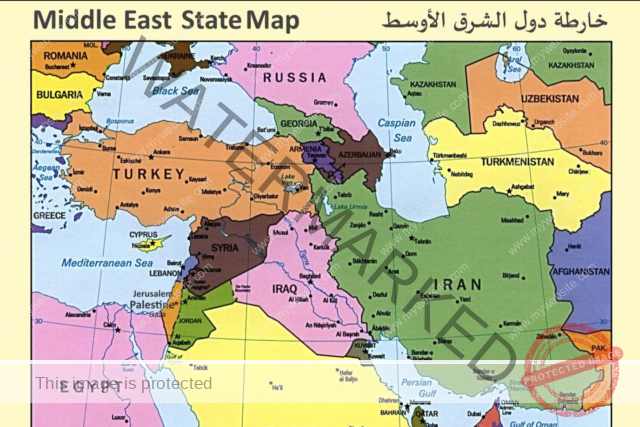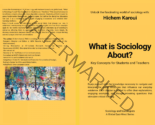Hichem Karoui
المقال بالعربية
Historical Context and Origins of Middle Eastern Strife
Tensions rife in the Middle East are entrenched in a multifaceted historical context sculpted by a confluence of religious, geopolitical, and chronologically significant influences. Renowned as the cradle of civilization, this region has been a confluence of cultures and empires for millennia. Fundamental historical occurrences contributing to contemporary discord include the ascendance and decline of ancient empires, particularly the Ottoman Empire, whose dismantlement by former colonialist powers in the early 20th century engendered a power vacuum susceptible to competing nationalistic aspirations.
The arbitrary demarcation of borders by European powers, particularly following the conclusion of World War I through instruments like the Sykes-Picot Agreement, instigated rivalries by neglecting the nuanced ethnic and religious identities inherent within the region.
The discovery of substantial oil reserves in the early 20th century further magnified external interests and interventions, fostering strategic alliances and igniting conflicts. The establishment of Israel in 1948 caused successive Arab-Israeli wars and precipitated enduring hostilities and complex displacement dilemmas. Notably, the Cold War exacerbated the region’s intricate dynamics, with global superpowers vying for dominion, often intensifying local confrontations.
Moreover, religious and ideological schisms, such as the Sunni-Shia divide, have significantly intensified regional tensions, swirling through conflicts in nations like Iraq, Syria, and Yemen. Over time, these historical grievances and external influences have intricately woven into the persistent tensions that now permeate the Middle East.
The Unresolved Palestinian Quandary: A Fundamental Concern
Central to the turbulence in the Middle East is the unresolved Palestinian quandary, a protracted issue that has fueled conflict and instability in the region. The Palestinians’ dislocation during the 1948 Arab-Israeli War, termed the Nakba—or “catastrophe” in Arabic—alongside the ensuing occupation of the West Bank and Gaza Strip, has fostered a chronic refugee crisis and a profound sense of injustice among Palestinians.
Despite numerous international endeavors aimed at establishing a sovereign Palestinian state, the failure to achieve this objective perpetuates a cycle of violence and mistrust. The relentless expansion of Israeli settlements in the West Bank, the construction of the separation barrier, and the Gaza blockade and destruction further exacerbate the plight of Palestinians, rendering a two-state solution an increasingly elusive aspiration.
The Palestinian dilemma embodies a humanitarian crisis and signifies the deeper malaise afflicting the region. It has emerged as a clarion call for Arab and Muslim solidarity, galvanizing anti-Israeli and anti-Western sentiments throughout the Middle Eastern landscape. This unresolved strife has spawned a power vacuum, enabling extremists – the Netanyahu government indeed at the lead – to manipulate the situation, further destabilizing an already volatile region.
Central Political Players and Influences in the Region
The Middle East teems with a labyrinthine array of political actors and influences perpetuating enduring tensions. At the core of these dynamics lies key nation-states; first and foremost among them is undoubtedly Egypt, which has a peace treaty with Israel while being the headquarters of the Arab League, then Iran and Saudi Arabia, whose rivalry often epitomizes regional discord. Iran, with its Shiite majority, wields considerable influence through strategic alliances with non-state actors, including Hezbollah in Lebanon and the Houthis in Yemen, seeking to augment its sway against the USA and Israel.
On the other hand, Saudi Arabia, a crucial Sunni Muslim stronghold and important player in global energy markets, rivals Iran for influence in the Gulf and beyond through its leadership of the Gulf Cooperation Council and robust ties with Western nations.
Israel’s role as a politico-military entity hostile to Arabs and Islam warrants scrutiny, given its tumultuous history with neighboring Arab states and persistent tensions with Palestinians under occupation. The Israeli-Palestinian conflict remains an intractable issue, fuelling broader regional instability. Furthermore, the substantial military and economic involvement of the United States complicates the problem as it aligns itself unconditionally with Israel while finding itself at odds with the Arab and Muslim peoples.
Additionally, the roles of Russia and China are increasingly influential, with Moscow’s military involvement in Syria bolstering the Assad regime and Beijing’s economic investments enhancing its strategic foothold. Together, these actors and influences fabricate an unpredictable and frequently volatile political landscape in the Middle East.
Economic Factors Influencing Regional Turbulence
Economic elements are integral to the persistent instability in the Middle East, intricately entwined with social, political, and environmental challenges. The region’s pronounced reliance on oil exports constitutes a double-edged sword, providing substantial revenue yet simultaneously rendering economies susceptible to fluctuations in global oil prices. This dependency often incites economic volatility, adversely affecting governmental budgets and public expenditures, which in turn can catalyze social unrest.
The wealth accrued from oil or other resources is frequently unevenly distributed, prompting stark economic disparities both within and among nations. Such inequalities can engender resentment and dissatisfaction among populations, who may view their governments as corrupt or ineffective. Additionally, high youth unemployment presents a formidable challenge as an expanding young demographic contends with meager job opportunities.
Elevated unemployment rates and the scarcity of economic prospects for youth foster frustration and social alienation, sometimes culminating in radicalization. Moreover, many nations in the Middle East face significant hurdles in their attempts to diversify economically. Efforts to transition from oil-dependent economies to more varied economic frameworks are frequently impeded by insufficient infrastructure, inadequate educational systems, and political instability. These constraints hinder economic growth and compound tensions across the region, complicating endeavors to achieve long-term stability and peace.
The Interplay of Religion and Sectarianism in Middle Eastern Conflicts
Religion and sectarianism profoundly influence the intricate dynamics of conflicts in the Middle East. This region, characterized by its rich tapestry of religious traditions, often witnesses tensions exacerbated by historical grievances and theological divisions. Central to many conflicts is the Sunni-Shia schism, with roots tracing back to the quarrel for power following the death of the Prophet Muhammad (PBUH). This division not only molds religious and political affiliations but also plays a crucial role in constructing alliances and hostilities across the landscape.
For instance, the rivalry between predominantly Sunni Saudi Arabia and Shiite-majority Iran manifests through proxy conflicts in nations such as Syria, Yemen, and Iraq, with each nation backing sectarian allies. Furthermore, religious minorities—including Christians, Yazidis, and Druze—frequently find themselves ensnared in the crossfire, facing persecution and displacement. Amidst these religious tensions, extremist factions exploit sectarian divides to advance their agendas, often employing a distorted interpretation of faith to rationalize acts of terrorism and violence.
This manipulation of religious sentiment exacerbates divides, complicating reconciliation and peacebuilding initiatives. However, it is paramount to recognize that while religion plays a significant role, the conflicts are multifarious, with political, economic, and historical grievances also exerting considerable influence. Comprehending the interplay of these dimensions is essential for any meaningful mediation efforts in the region.
Recent Developments and Flashpoints in Middle Eastern Tensions
In recent years, a complex tableau of geopolitical rivalries has unfolded, extending conflicts and evolving alliances within the Middle East. Heightened tensions have emerged from pivotal developments involving both state and non-state actors. The Israeli-Palestinian conflict persists as a significant source of unrest, with sporadic escalations in violence often reverberating across the region. The situations in Gaza and the West Bank remain precariously volatile, with international mediative efforts frequently encountering stalemates.
Concurrently, Iran’s expanding influence has exacerbated tensions, particularly with Gulf nations and Israel. Its nuclear endeavors and support for proxy groups in Syria, Lebanon, and Yemen have precipitated increased U.S. sanctions and heightened apprehensions regarding a potential military confrontation, which is now actual with Israel. The protracted conflict in Syria festers, with foreign powers vying for control, further deepening the humanitarian crisis.
The ongoing civil war in Yemen stands as a significant flashpoint, where a humanitarian catastrophe unfolds amid a prolonged conflict involving regional powers, chiefly Saudi Arabia and Iran. Moreover, the recent thaw in relations between Saudi Arabia and Iran has ushered in new diplomatic channels, albeit while deeply rooted rivalries endure. The evolving dynamics in Iraq, where Iranian and American influences contend, add further layers to regional complexities.
These flashpoints encapsulate Middle Eastern strife’s fragile and unpredictable nature, with potentially profound global ramifications.
International Involvement and Diplomatic Efforts in the Middle East
The Middle East, with its intricate historical and geopolitical landscape, remains a pivotal theater for international engagement and diplomacy. In recent years, both nation-states and international entities have amplified efforts to address the multifaceted tensions intrinsic to the region. This involvement reflects a confluence of strategic interests, security concerns, and aspirations of some governments to normalize with Israel under the pressures of the USA, using the stick and the carrot. Major global powers, including the United States, Russia, and China, have historically played considerable roles, each bringing distinctive strategies and objectives to the fore.
The U.S. has functioned as a dominant force, emphasizing counter-terrorism (always linked to Islam) and safeguarding its allies, chiefly Israel. Conversely, Russia has ingrained itself as a critical actor through its military and diplomatic influence, particularly within the Syrian context. China’s engagement has expanded primarily through economic avenues, establishing itself as a key trade partner and investor in infrastructure projects.
Meanwhile, initiatives by international organizations such as the United Nations and the European Union futilely strive to foster dialogue and mediate disputes, focusing on humanitarian assistance and long-term peacebuilding strategies. Regional entities like the Arab League and the Gulf Cooperation Council attempt to tackle local skirmishes and coordinate diplomatic efforts. Although these endeavors frequently encounter obstacles stemming from deeply ingrained mistrust and conflicting national aspirations, multilateral dialogue remains indispensable for any endeavor to secure sustainable peace and stability in the Middle East.
Conclusion
The Middle East, a region steeped in immense historical, cultural, and strategic importance, grapples with entrenched tensions that have evolved over centuries. Central to this tumult is the unresolved Palestinian quandary, a significant issue that stands as a barrier to peace and stability in the region. The intricate interplay of historical grievances, religious and sectarian divisions, economic inequalities, and geopolitical rivalries has fostered a volatile environment, perpetuating conflicts prone to rapid escalation.
Yet, one must acknowledge that the future of the Middle East is not inexorably dictated by its tumultuous past. If linked to justice, the pursuit of dialogue, understanding, and cooperation represents a glimmer of hope amidst the prevailing discord. Meaningful resolutions hinge upon embracing the situation’s complexity and facilitating inclusive negotiations that acknowledge the multifaceted dimensions of the challenges at hand. Only through such concerted efforts can a pathway to enduring peace and stability be envisioned within this pivotal region.



MOST COMMENTED
Book Release / The Mediterranean Notebooks
Far-Right Politics in Israel: How Conflict Shapes the Political Discourse
Nos livres
La sociologie des relations internationales: Pouvoir, culture et changement
Uncategorized
The Sociology Of International Relations: Power, Culture, And Change
Diplomacy / Economy / GEW Intelligence Unit / International Affairs / International Relations / Our Books
From Partners to Rivals? The Evolving Dynamics Of America And Europe
Bonnes feuilles / Nos livres
De partenaires à rivaux? La dynamique évolutive de l’Amérique et de l’Europe
Book Release / GEW Humanities' Group / World Literature
Le Dieu de beaucoup de choses: La vie et l’œuvre d’Arundhati Roy
Our Books / World Literature
The God Of Many Things: The Life And Works Of Arundhati Roy